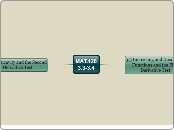MAT.126
3.3-3.4
3.3 Increasing and Decreasing Functions and the First Derivative Test
Determine intervals on which a function is increasing or decreasing
Definitions
Theorem 3.5
Test for Increasing and Decreasing Functions
Guidelines
Apply the First Derivative Test to find relative extrema of a function
Theorem 3.6
The First Derivative Test
3.4 Concavity and the Second Derivative Test
Determine intervals on which a function is concave upward or concave downward
Definition
Understand concavity graphically
Theorem 3.7
Test for Concavity
Use x-values where f''(x)=0 or f'' does not exist to determine test intervals
Find any points of inflection of the graph of a function
Definition
Theorem 3.8
Points of Inflection
Apply the Second Derivative Test to find relative extrema of a function
Theorem 3.9
Second Derivative Test
